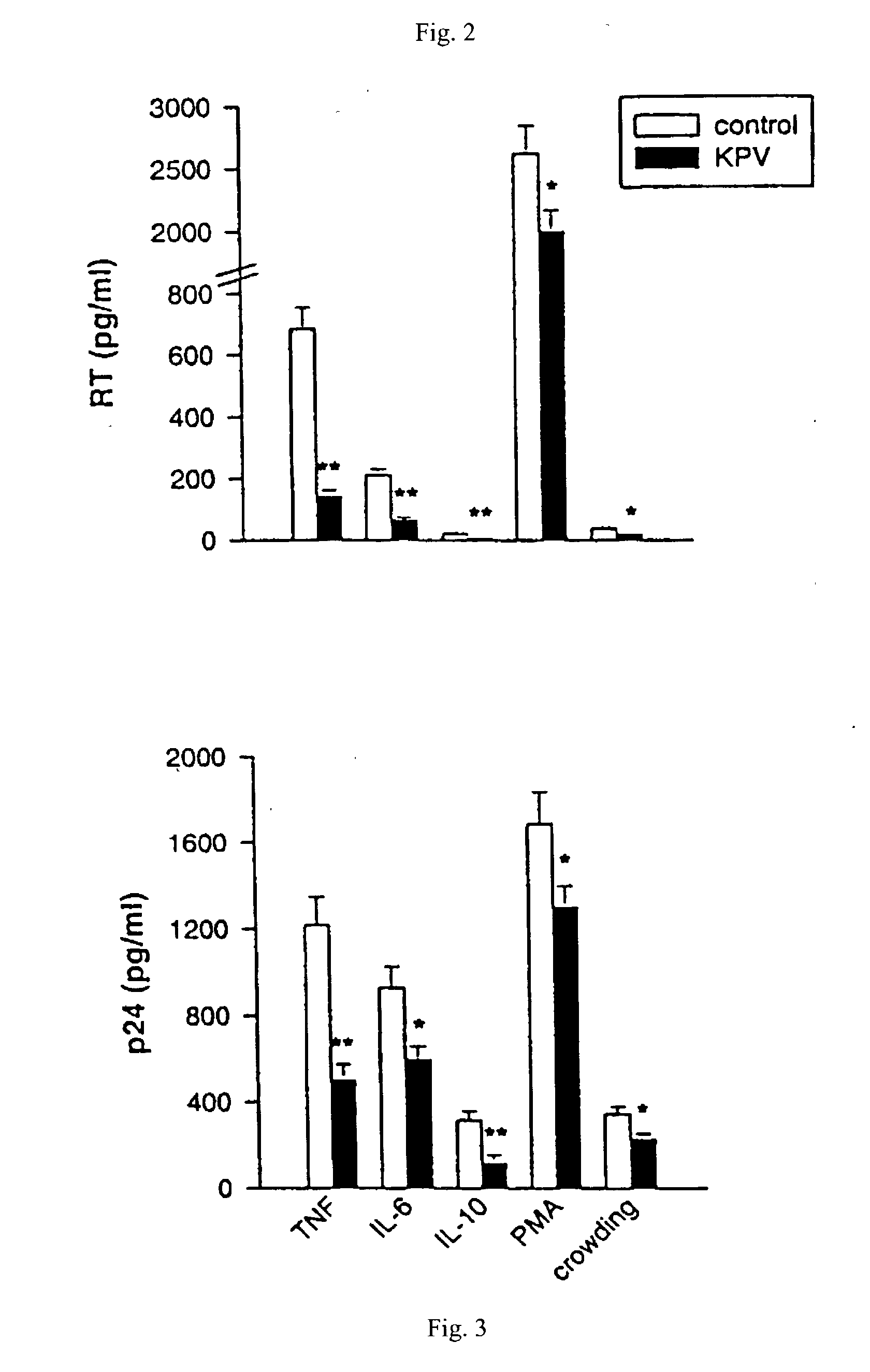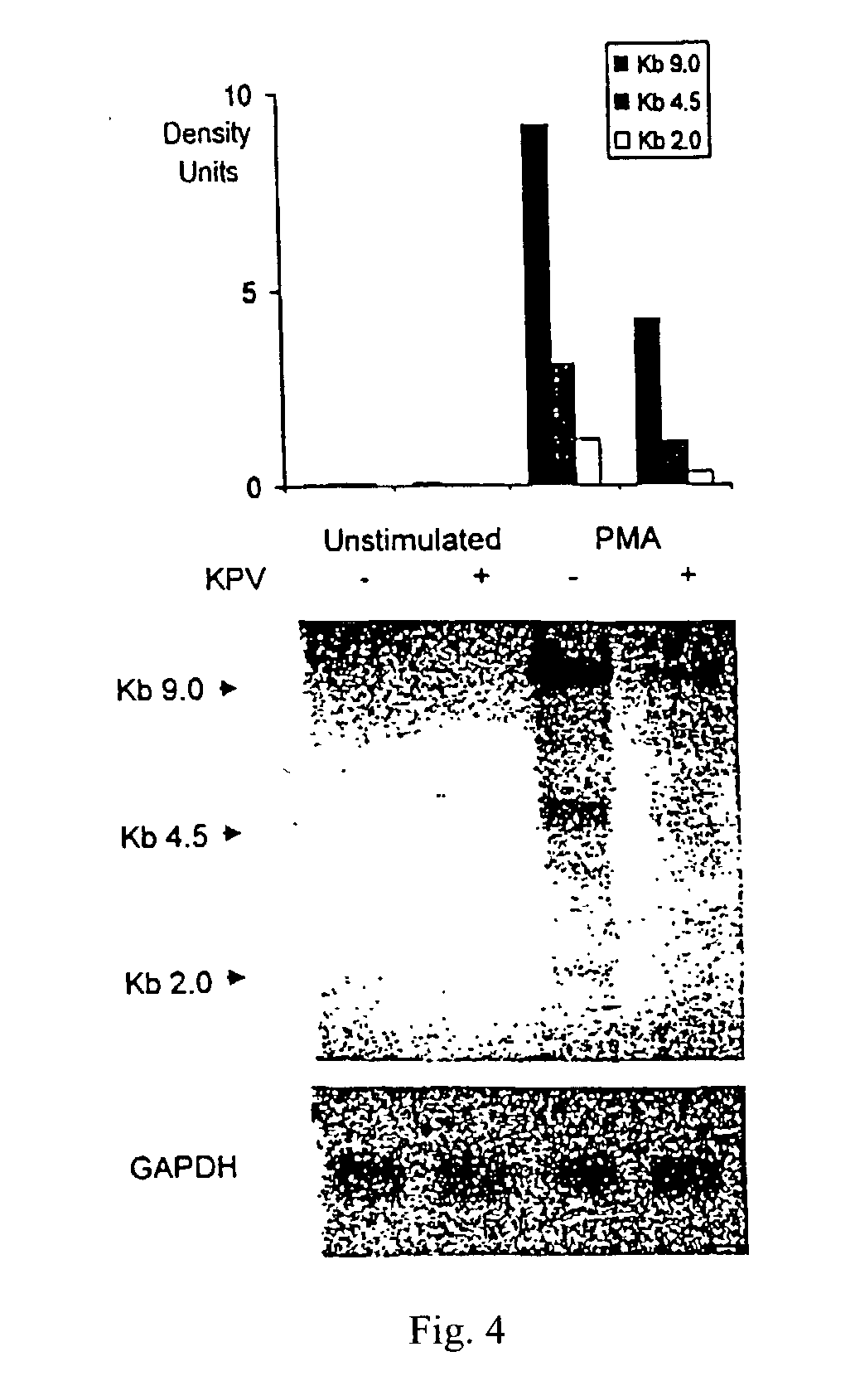Treatment of ophthalmic conditions
a technology for ophthalmic conditions and treatment methods, applied in the field of treatment of ophthalmic conditions, can solve the problems of increased fatigue and strain on the eyes, blurred vision, inflammation of the eyes, etc., and achieve the effect of enhancing growth
- Summary
- Abstract
- Description
- Claims
- Application Information
AI Technical Summary
Benefits of technology
Problems solved by technology
Method used
Image
Examples
example i
Formation of the .alpha.-MSH Peptides and Derivatives Including KPV Dimer
[0045] The peptides used in the examples included: .alpha.-MSH (1-13) (SEQ. ID NO 4), .alpha.-MSH (SEQ. ID NO. 2) which is MEHFRWG, .alpha.-MSH (6-13) (SEQ. ID NO. 3), and .alpha.-MSH (11-13) (SEQ. ID NO. 1), all of which were N-acetylated and C-amindated, and ACTH (1-39) (SEQ. ID NO. 21) and ACTH (18-39) (SEQ. ID NO. 22) which is also called CLIP. The peptides were prepared by solid-phase peptide synthesis and purified by reversed-phase high performance liquid chromatography. Another peptide used in this research included a dimer of the amino acid sequence KPV (SEQ. ID NO. 1), specifically VPKCCKPV (SEQ. ID NO. 5), which also was N-acetylated and C-amidated (the "KPV dimer"). The VPKCCKPV (SEQ. ID NO. 5) can be chemically represented as Val-Pro-Lys-AcCys-s-s-CysAc-Lys-Pro-V-al or VPKC-s-s-CKPV. The VPKCCKPV (SEQ. ID NO. 5) is formed by adding cysteines at the N-terminal of KPV (SEQ. ID NO. 1) peptide and allow...
example ii
The Peptides Inhibit HIV-p24 Expression in HIV Infected Cells
[0046] An HIV-1 infected promonocytic U1 cell line was maintained in complete culture medium (RPMI 1640 supplemented with 10 mM Hepes), 2 mM L-glutamine (Sigma-Aldrich), 10% heat-inactivated FCS (HyClone Laboratories, Logan, Utah, USA), penicillin at 100 units / mL and streptomycin at 100 .mu.g / mL (Gibco Laboratories, Grand Island, N.Y.) in log phase of growth. Before use, cells were washed three times with HBSS (Gibco) to remove extracellular virus. Cells were plated onto 24-well flat-bottomed plates at a concentration of 2.times.10.sup.6 / mL (final volume 1 mL) with medium plus TNF-.alpha.(10 ng / mL (R&D Systems, Oxford, England, UK) in the presence or absence of .alpha.-MSH peptides in concentrations from 10.sup.-13 to 10.sup.-4 M. Supernatants were removed by centrifugation after 48 hr incubation at 37.degree. C. in 5% CO.sub.2, and tested for HIV-p24 release. p24 antigen releases (Cellular Products Inc. Buffalo, N.Y., USA...
example iii
The Peptides Inhibit HIV-p24 and Reverse Transcriptase Expression in HIV Infected Cells Stimulated by TNF-.alpha., IL-6. IL-10, and PMA.
[0047] HIV-1 infected promonocytic U1 cells were plated onto 24-well flat-bottomed plates at a concentration of 2.times.10 / mL (final volume 1 mL) with medium alone or TNF-.alpha.(10 ng / mL), IL-6 (20 ng / mL), IL-10 (20 ng / mL (R&D Systems) or PMA (1 ng / mL) (Sigma-Aldrich Chemicals, St. Louis, Mo., USA) in the presence or absence of KPV (SEQ. ID NO. 1) in concentrations of 10.sup.-5 M. Supernatants were removed by centrifugation after 48 hr incubation at 37.degree. C. in 5% CO.sub.2, and tested for HIV-p24 release and reverse transcriptase release. In crowding experiments, U1 cells were seeded at the density of 2.times.10.sup.5 mL and maintained in culture at 37.degree. C. in 5% CO.sub.2 without change of medium for 7 days. KPV (SEQ. ID NO. 1) in concentrations of 10.sup.-5M were added on day 1. p24 antigen releases (Cellular Products Inc. Buffalo, N.Y....
PUM
| Property | Measurement | Unit |
|---|---|---|
| Fraction | aaaaa | aaaaa |
| Fraction | aaaaa | aaaaa |
| Fraction | aaaaa | aaaaa |
Abstract
Description
Claims
Application Information
 Login to View More
Login to View More - R&D
- Intellectual Property
- Life Sciences
- Materials
- Tech Scout
- Unparalleled Data Quality
- Higher Quality Content
- 60% Fewer Hallucinations
Browse by: Latest US Patents, China's latest patents, Technical Efficacy Thesaurus, Application Domain, Technology Topic, Popular Technical Reports.
© 2025 PatSnap. All rights reserved.Legal|Privacy policy|Modern Slavery Act Transparency Statement|Sitemap|About US| Contact US: help@patsnap.com



